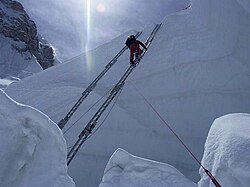Expedition climbing (or expedition-style or pejoratively siege climbing) [1] [2] is a type of mountaineering that uses a series of well-stocked camps on the mountain leading to the summit (e.g. Base Camp, Camp 1, Camp 2, etc.), that are supplied by teams of mountain porters. [2] In addition, expedition climbing can also employ multiple 'climbing teams' to work on the climbing route—not all of whom are expected to make the summit—and allows the use of supports such as fixed ropes, aluminum ladders, supplementary oxygen, and sherpa climbers. [2] By its nature, expedition climbing often requires weeks to complete a given climbing route, and months of planning given the greater scale of people and equipment that need to be coordinated for the climb. [2] [3]
Contents
'Expedition style' climbing is in direct contrast to 'alpine style' climbing, which involves a single small fast-moving summit climbing team that carries all their supplies and equipment (e.g. no mountain porters or sherpas) and makes little use of support (e.g. no supplementary oxygen or fixed ropes). [4] [5] As a result of having less equipment and supplies, alpine-style teams need to complete their climbing route in days and it is thus considered a riskier form of mountaineering (e.g. if they get trapped in a storm, they have no supplies to wait for the storm to pass). [2] Some argue that this risk is balanced by the fact that alpine-style teams spend less time on the mountain, thus reducing their exposure to other serious risks such as from avalanches and seracs. [1]
Expedition-style was the type of mountaineering Sir Edmund Hillary and Tenzing Norgay used in summitting of Mount Everest, [1] [2] as well as on most major Himalayan mountains — including many of the eight-thousanders — and is thus sometimes termed Himalayan climbing. [1] [2] From the 1970s, leading mountaineers began to favor the 'purer' challenge of alpine-style climbing, led by pioneers such as Reinhold Messner and Peter Habeler, and Doug Scott, Peter Boardman and Joe Tasker. [1] From 2006 onwards, mountaineering's highest award, the Piolets d'Or ceased to recognize expedition-style first ascents, and in 2008 amended their charter to focus exclusively on alpine-style ascents. [6] [7] Expedition climbing techniques are still widely used by commercial adventure companies to guide less experienced clients on Seven Summits or 'accessible eight-thousander' tours, which has brought new risks (e.g. 1996 Everest disaster). [5] [8]






